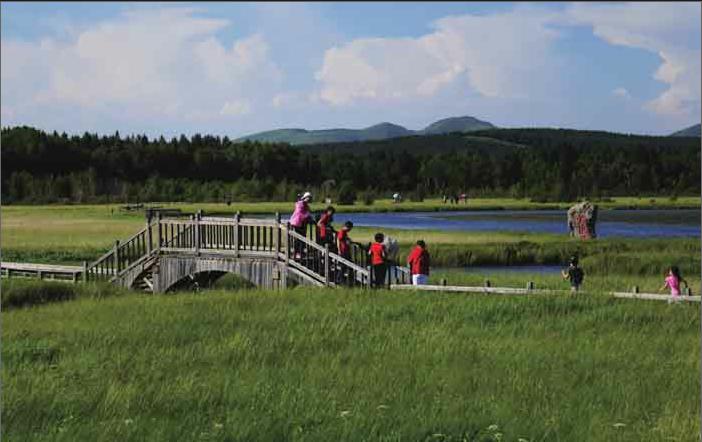DESERT WARRIORS
2017-09-29ByWangHairong
By+Wang+Hairong


A giant tree rules the large fields dotted with wildflowers in the Saihanba Jixie Forest Farm. Planted in the Qing Dynasty (1644-1911) period, the nearly 20-meter larch is said to have survived 200 years of vicissitudes. Belying its age, it still looks vigorous and indefatigable with branches stretching out and its strong trunk wrapped with red ribbons.
The locals in Weichang Manchu and Mongolian Autonomous County in north Chinas Hebei Province, where the farm is located, have tied these ribbons. The act is to express their gratitude. The immense tree has been the savior of the area, rekindling hope of transforming a once barren land into lush green forest.
“We call it the blessing tree. Without it, todays Saihanba would not have been possible,” Zhao Yunguo, an administrator of the forest farm, said.
The Saihanba Jixie Forest Farm is the largest artificial forest on earth. Its forest area of 74,700 hectares means the green cover ratio has soared from 11.4 percent approximately half a century ago to 80 percent today.
It is not only a gigantic windbreaker that shelters Beijing and its adjacent areas from wind and encroaching sand, but also a popular tourist destination. Larch and other tree species have added various shades of green to the landscape, while blooming wildflowers create different gaily colored patterns to the fields, creating picturesque scenes that draw admiring visitors from far and near.
Saihanbas achievements have won national recognition. On August 28, commenting on the feat of the builders of the forest farm, President Xi Jinping said that in 55 years, they have transformed a wasteland of yellow sand, where birds had no tree to perch on, into a green sea. With this feat, they have demonstrated that green mountains are mountains of gold and clear water streams of silver. Their story is inspirational and a vivid example for promoting ecological progress.
Witness to change
The area where the tree stands was a royal hunting ground during the Qing Dynasty, where trees luxuriated with an abundance of green grass. It teemed with game animals and the aristocracy came to demonstrate their hunting skills. It is said that it was here where Emperor Kangxi, (1654-1722), one of the most revered rulers in Chinese history, once welcomed triumphant soldiers returning from a victorious battle in the north.
At the end of the Qing Dynasty, the trees in the forest began to be chopped down and the land was farmed ruthlessly to produce more food. It resulted in deforestation and gradually, the fields were reduced to wasteland. With the forest having disappeared, the local weather became drier.endprint
In the 1950s, the Saihanba area, lying about 400 km from Beijing, was ravaged by sand. Northern winds then swept the sand farther, dumping it in Beijing. Data from the China Meteorological Administration show that during this period, Beijing suffered 56.2 days of sandstorm in a year, on an average.
In the 1960s, the government decided to restore Saihanbas lost greenery. Liu Kun, then Deputy Director of the bureau administering state-owned forest farms under the Ministry of Forestry, was assigned to conduct a feasibility study for establishing a forest farm in Saihanba.
Liu arrived in Saihanba with six other experts in October 1961. They examined the area to determine which types of plants would be suitable to grow there. On the first two days, the team could find no trees except for some withered larch roots beside some rocks.
On the third day, they spotted the giant larch standing upright against the bitingly cold wind. They were so excited by the sight that they hugged it in relief for it indicated that at least one tree species could survive the harsh weather condition there.
Then the Saihanba Jixie Forest Farm began to take shape. The next year, over 300 people from across the country, including fresh graduates, arrived to plant the trees. In two years, these planters, whose average age was 24, planted larch saplings on more than 400 hectares. However, to their dismay, fewer than 8 percent of the saplings survived.
“It was not because they chose the wrong species,” recalled Zhang Xing, a retired worker on the farm. “The problem was that the saplings were shipped from northeastern China. So after the long journey, the roots withered from water loss. How could they live?”
To overcome this problem, the planters decided to grow seedlings locally by themselves. They sowed seeds in early spring, and then carefully nurtured the sun-loving saplings, which became stout and sturdy. In the spring of 1964, these saplings were planted and the toilers were delighted to see that this time, more than 90 percent had survived. Thereafter, year after year, they planted more trees, turning the whole area into forested land.
A breath of fresh air
As the larch trees grew, they shed their needle-shaped leaves, which decomposed over the course of time, providing nutrients to nourish other vegetation such as shrubs and flowers. As the forest grew denser with more varieties of vegetation, it attracted wild animals such as boars, badgers, deer and birds, who settled there, filling the woods with vitality and restoring the ecological system.endprint
Now, Saihanba has 261 invertebrate species, 660 insect species, 179 fungus species and 625 plant species, according to a Xinhua News Agency report.
The forest ecosystem provides huge environment benefits. The Chinese Academy of Forestry has estimated that the forest can absorb 747,000 tons of carbon dioxide, release 545,000 tons of oxygen, and conserve and purify 137 million cubic meters of water.
“Left to nature, it would have taken at least 100 years to restore the barren sandy land, while Saihanba regained its forest ecosystem in only 50-plus years, making an important contribution to Chinas ecological progress,” said Huang Xuanrui, President of the College of Forestry, Agricultural University of Hebei.
The desertification and sandification monitoring report released by the province in 2009 showed that in the previous five years, the sandified land near Beijing and Tianjin had shrank by 74,700 hectares.
The annual average sandstorm days in Beijing have now been reduced to about 7.5 days and the annual average precipitation increased by 66.3 mm. The number of strongly windy days has been reduced by 30 days.
As the farm went into operation with large-scale tree planting mostly completed in the 1980s, the question was how to make it sustainable and profitable.
With logging being the traditional business model for state-owned forest farms, a hard fiberboard plant was set up in Saihanba in 1981 to process the inferior-quality trees rejected for farm use. This became a major revenue source. In 2000, income from logging accounted for more than 90 percent of the farms total earnings. To conserve forest resources, since 2012, the farm has almost halved the amount of timber harvested and the share of timber income has been slashed to 40 percent of the total.
Today, a more profitable business than logging is selling saplings of spruce, larch and Mongolian scotch pine. A 15-year-old spruce tree, that is usually around 7 meters tall, can fetch the same amount of money as timber from 30 trees of the same age, according to Wang Liming, in charge of the farms plant nursery.
The farm has become an important sapling nursery in north China. In 2016, sapling sales generated an income of more than 11.95 million yuan ($1.82 million). By reducing logging and expanding the sapling nursery, the farm has also increased the forest volume and area.
A side business of the farm is ecotourism. According to the countys Culture and Tourism Bureau, there are over 500,000 visits to Saihanba annually, yielding more than 40 million yuan ($6 million) and creating 15,000 direct jobs. Local residents benefit from this by providing lodging, catering and transportation services and selling artifacts and other specialty products. Every year, tourism adds more than 600 million yuan($90 million) to the local economy.
Saihanba has also launched a carbon sequestration project. Liu Haiying, head of the forest farm, told the media that the farms total volume of sequestered carbon is equivalent to 4.75 million tons of carbon dioxide. So far, 183,000 tons of sequestered carbon had been listed for sale. If all the sequestered carbon is sold, it will generate at least $15.19 million of revenue.
The whole society should adhere to the concept of green development, carry forward the spirit of Saihanba, and persevere in promoting ecological progress, generation after generation, President Xi said on August 28. He called for leaving a legacy for future generations: “Efforts should be made to promote the harmonious development of man and nature…make our great motherland more beautiful, and leave a bluer sky, greener mountains and clearer water for the future generations.”endprint
